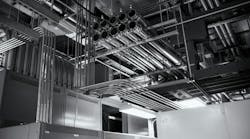Is the equipment you’re about to work on really de-energized? How do you know? Did you flip a breaker and the light went off? Maybe you looked at the electrical drawings and verified with your DMM that the supply breaker is off. But this doesn’t necessarily mean the equipment is de-energized.
The drawing might not be complete or current. For example, undocumented cross-wiring or backfeeds can energize a circuit whose supply breaker is off. So can batteries and capacitors. Of course, you’d catch these sources with your DMM. But you might not catch voltage induction into the circuit you’re working on. You must isolate at all energy input points, not just at the breaker. You can receive a shock (or be exposed to arc blast) from nearby equipment you didn’t de-energize. Your elbow is a potential conductor, as are your tools or other items you may be using.
Electricity isn’t the only energy source to protect against. Gas cylinders, mechanical coils and springs, hydraulic systems, pneumatic devices and circuits, and various types of inertia and gravity feed systems may be present (and even undocumented).
The key to full de-energization is making sure you understand the major processes of the equipment. For example, if you’re working on the controls for a hydraulic press maybe you de-energize it by lowering the press to its stop position and opening the pressure bleed valve.



